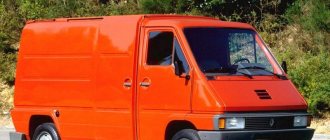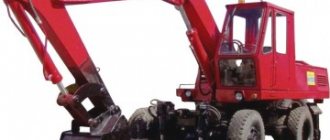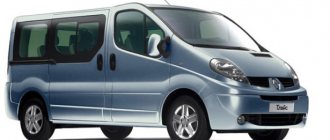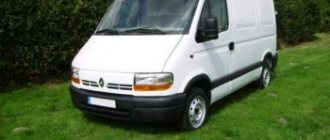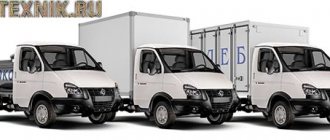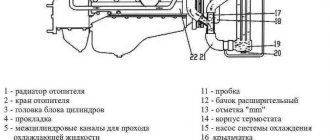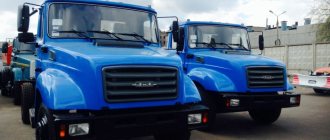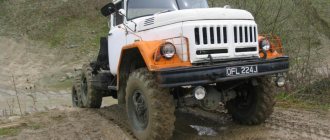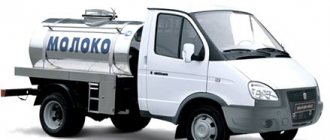from 2362800 rubles
ORANGE (OV 031)
Application for a car Sign up for a test drive Application for a loan Sign up for a service
- Description
- Characteristics
- Options and prices
- Credit
- Insurance
- Stock
- Additionally
- Accessories
A little about the history of the model
Production of the 1st generation Renault Master started in 1980. These trucks were produced in collaboration with Fiat and were equipped mainly with 2.4 liter Fiat-Sofim diesel engines, and since 1984 - with another option, also a diesel engine, with a displacement of 2.1 liters. For those interested, Renault Master with Renault gasoline engines of 2.0 and 2.2 liters was also on sale.
Renault Master was one of the first in this segment to use a sliding side door. The “highlight” of the model was the unusual round door handles (similar to the handles on the Fiat Ritmo).
1st generation car
Based on the Renault Master, vehicles with a larger payload capacity were developed and put into mass production. They received the name Renault B, on a rear-wheel drive chassis. From 1990 to 1999, a 4x4 all-wheel drive version was also produced. In 1993, Renault B cars received their own style (a different radiator grille) and a new independent model name - Renault Messenger.
The 2nd generation (1998-2010) became “an even more joint project” - developed by Renault together with Nissan and Opel. Therefore, in addition to the Renault Master, practically its twins were produced, under the names Opel Movano and Nissan Interstar. Trucks of this 2nd generation were equipped with Renault S8W/S9W, S9U, G9T and Nissan YD diesel engines, with working volumes of 2.2, 2.5 and 2.8 liters.
2nd generation car.
At the end of 2003, the company restyled the exterior of the car and its interior. The second generation retained and added new capabilities to the main advantage of this model: its versatility. These vans could be adapted for any need: from distributing goods around the city to being used as an ambulance.
The third generation Renault Master, which was launched on the market in May 2010, is also produced under several “clone” brands: Opel / Vauxhall (for Britain) Movano and Nissan NV400. Cars of all these brands are equipped with the same 2.3 liter Renault diesel engine, available in 3 power options - from 100 to 150 horsepower.
Of the total number of Masters produced, 75 percent are from Renault. The remaining 25% are the same light-duty vehicles under the Opel (for continental Europe) and Vauxhall (for the UK and other right-hand drive countries) brands.
Renault Master trucks are produced exclusively at the SoVAB plant in Batilla, in north-eastern France. This company also produced cargo vans of this brand of the previous two generations.
To start production of third-generation cars, the automaker invested approximately 151 million euros in the plant. Most of these investments were used to modernize welding equipment in the body and paint shops. The first division was updated with a fully automated body welding line consisting of 250 robots, and the second division was updated with the ability to paint vehicles with extra-long vans (L4 version, up to 6.848 m long).
PURPOSE
Since the start of production, the Renault Master has been available in various variations, including long wheelbase models. The most widespread are vans designed for transporting small volumes of cargo. The passenger version was used to transport people (17 people - European countries, 19 people - Russia). On-board variations and versions with special add-ons were also in demand.
Renault Master models with increased payload capacity were produced by the Renault Trucks division under the name Renault B (Renault Messenger and Renault Mascott).
It should be noted that the series has found wide application not only as a commercial vehicle, but also as a car for the family.
Execution options
Renault Master cars are available with both front-wheel drive and rear-wheel drive (the latter can be with a single or double tire option. The gross vehicle weight can range from 2.8 to 4.5 tons.
There are 3 wheelbase options, 2 rear overhang length options, and 3 different height options. Also, to the list of available design options, you need to add the presence of vans of various capacities (from 8 to 15.8 cubic meters, with a maximum load capacity of 2254 kg), combi, minibuses, chassis with single and double cabs (with a maximum load capacity of 2495 kg). In total, the combination of all possible ones allows us to produce up to three hundred and fifty different designs.
In the cargo compartment, innovations concerned the use of wider side (+17 centimeters) and rear doors. As an additional option, it is possible to install rear doors that can swing open 270 degrees. Also in the new generation of small-tonnage vehicles, the loading height was reduced: for front-wheel drive versions - to 542 mm, for rear-wheel drive versions with single-pitch tires - to 672 mm, with dual-pitch tires - up to 700 mm.
At the start of the 3rd generation, in 2003, the Renault Master looked like this
Renault Master vans are supplied as standard in an all-metal design, and on special order - with glazing in the cargo compartment. The floor of the cargo compartment is covered with 10 mm thick wooden flooring. For more severe operating conditions, it is planned to install a more durable flooring, 15 mm thick. Additional accessories include wooden guides along the inner sides of the body and fittings for securing the cargo from movement.
All versions of the Master family cars are equipped with disc brakes: with ventilated discs at the front and regular discs at the rear. For front-wheel drive versions, ABS and EBD are standard, and ASR is optional.
A significant number of innovations also affected rear-wheel drive modifications of Renault Master. In addition to the monocoque body (previously a model with a body on a frame chassis was produced), which has a rigid structure aimed at improving handling and increasing load capacity, the L4 modification was also added with the length of the cargo compartment increased to 4.38 m. At the same time, the useful volume can reach 15.8 cubic meters (in the L4H3 version).
Rear-wheel drive modifications are available with a gross weight of 3.5 and 4.5 tons. The first option is available with single or double slope tires, and the second - exclusively with dual slope. For variants with single-pitch tires, double-leaf springs are mounted, and for those with dual-pitch tires, three-leaf springs are installed.
Modifications
The manufacturer has offered as many as 10 versions with different dimensions and load capacity:
- L1 H1 – 919 kg load capacity and 5048 mm length;
- L1 H1 – with a carrying capacity of 1578 kg and the same length;
- Renault Master L2 H2 – withstands 1498 kg, length does not exceed 5548 mm;
- L2 H3 for 1457 kg maximum load with a length of 5548 mm;
- L3 H2 capable of transporting 1455 kg with a vehicle length of 6198 mm;
- L3 H3 length is the same as the previous model, but the load capacity is 40 kg less;
- L3 H3 with a length of 6198 mm and a load capacity of 1105 kg;
- L4 H3 – load capacity 2059 kg, length does not exceed 6848 mm;
- The L4 H3 is the same length as the previous model and has the same lifting capacity.
The doors of all models have a magnetic fastening and open 270 degrees each.
Other features of the Renault Master cargo family
One of the main advantages of the Renault Master family of cars is the wide selection of options, trim levels and additional equipment, as noted earlier. This allows you to select a light-duty truck with the most optimal characteristics for each specific type of business.
Renault Master all-metal vans are suitable for solving the widest range of transport tasks in small and medium-sized businesses - thanks to five options for body size and useful volume, from 7.8 to 15.8 cubic meters.
The cars are suitable for everyday use in a modern metropolis. Five front-wheel drive versions of the all-metal Renault Master van have a total weight of 2.49 tons and a standard load capacity of less than one ton, thanks to which they can be used everywhere in Moscow: they are allowed to enter both the “cargo frame” zone and the city center.
After the facelift, its design has become much more modern.
For rear doors with locks, you can select an opening angle of 180° or 270 degrees (additional options). The coupling device will give the car the ability to tow trailers weighing up to three tons. For rear-wheel drive versions, a bumper with a step is provided by default. Pass-through cargo loading/unloading capability is available by ordering a second sliding side door that can be placed on the driver's side.
One light source is installed in the area of the rear and side doors. A 12-volt power outlet can also be installed in the cargo area. There are several types of cargo compartment lining, including plywood lining. The cargo compartment is separated from the driver's cabin by a metal partition, which is lined with felt on the side of the cabin. It can also be ordered with a window, or with a window and a protective grille. Reliable securing of the load is ensured by fastening rings in the floor, which can also be supplemented with rings on the walls of the van.
Depending on the configuration, the Renault Master car can be equipped with such additional accessories as: loading ladder; aluminum roof rack, which can be supplemented with a bridge; luggage arches.
Chassis
The suspension installed in front is of an independent type with a reaction rod that connects 2 levers. With this, the car owner always controls the trajectory of the car (even on wet surfaces). The wide track provides additional stability.
The suspension works in such a way that the stability of its functioning is almost independent of the vehicle load. The rear wheels have a heavy-duty trailing arm. When cornering, the new Renault Master 2022 rolls, but not much, like for a van, and the chassis holds its trajectory perfectly. The Frenchman is not a racing car. The vehicle is intended for cargo or passenger transportation.
And for such tasks it copes well. Even if the Renault Master 2022 is maximally loaded, the van does not look helpless. The brake system of the new product is characterized by increased efficiency. The front wheels are equipped with disc brakes that support the ventilation function, while the rear wheels have simple disc brakes.
Engines and transmission Renault Master
Trucks of the Renault Master family are equipped with reliable and economical turbocharged diesel engines with a capacity of 125 or 150 horsepower (at a crankshaft speed of 3.5 thousand revolutions). These are four-cylinder, sixteen-valve power units of EURO-5 environmental class, with a Common Rail electronic diesel fuel injection system. The working volume of this engine is 2,299 cubic centimeters.
Renault's own engines, from the Kleon plant, are used as power units. They are equally suitable for both front-wheel drive (transverse engine) and rear-wheel drive (longitudinal engine) versions of the truck. Only in the first case the motor is installed transversely, and in the second it is located longitudinally.
These engines belong to the new, latest generation 2.3 dCi (M9T) diesel engines. They more fully meet the needs of commercial vehicles than their predecessors 2.0 dCi (M9R), but at the same time are smaller in size than 2.5 dCi (G9U) engines.
The fuel efficiency of the new engines, compared to their predecessors, has been improved by a full liter (in the case of front-wheel drive versions) and by 2.7 liters in the case of rear-wheel drive versions. For example, for front-wheel drive modifications in the combined cycle, diesel fuel consumption starts at 7.1 liters per 100 km (L2H2, 125 hp). 2.3 dCi engines can be combined with either a six-speed manual or an automated gearbox.
Diesel fuel consumption according to EEC 93/116 standards is: in the urban cycle - 9.5...9.6 liters per 100 km; in the extra-urban cycle – 7.1…7.3 liters per 100 km; in the combined cycle - 8.0...8.1 liters per 100 km. CO2 emissions are: 211…215 g/km. The fuel tank capacity is 100 liters.
Van powertrain
The Renault Master is equipped with a four-cylinder, sixteen-valve MR engine from Nissan, with an in-line arrangement of cylinders, having direct injection and supercharging.
The Renault Master engine has:
- volume 2.3 l;
- power 100–150 hp With.;
- torque (maximum) 248–350 N/m;
- environmental class Euro 4.
Those interested are offered cars in which the Common Rail system is installed.
Engine Renault Master
Related video: Renault Master - overview of body options
Publications on the topic
Description and characteristics of the Kemppi Master 202 welding machine
Advantages of Gazelle Next - an all-metal combi van with 7 seats
Mercedes Sprinter - general description and technical characteristics of the cargo van
Cabin Renault Master
The Renault Master cabin is made in full compliance with modern standards of comfort, convenience, visibility and ergonomics for this class of cars. It is quite spacious. The comfortable driver's seat is equipped with an armrest, height adjustment and lumbar support. The legroom at the bottom has increased by about 6-8 centimeters compared to the previous generation. All this helps to avoid fatigue on long trips.
Large double side mirrors, electrically heated and turn signal indicators, provide impeccable visibility. Also, as an additional option, fog lights are offered.
The informative instrument scale is equipped with a Russified on-board computer, which displays statistics on all key indicators of the car.
The list of additional options includes rear parking sensors; signaling; Cruise control; blind spot mirror – to control the traffic situation; suspended driver's seat; equipped with electric heating; central locking with remote control, which can be equipped with either a key with separate door opening or a “hands-free” key (with remote recognition); air conditioner equipped with a fine filter; modern audio system.
In third-generation cars, the approach to organizing the work and life of drivers was significantly changed. In particular, in the central part of the dashboard there is a retractable tablet for everyday work with documents in standard A4 format. It helps not only to keep track of the list of tasks scheduled for execution, but also to quickly make the necessary notes during the work process.
For the same purposes, a folding backrest for the middle seat is provided (if this is a version of a three-seater cabin). After a simple manipulation, it is transformed into a convenient table on which you can easily place a laptop or any other office equipment designed to make the driver’s work easier (he is also the forwarder, in most cases).
Salon
The latest generation of Renault Master has an incredibly well-thought-out internal arrangement. The cabin has countless compartments and storage for various items. Small niches and pockets allow you to place documents and small items inside. Visibility is excellent through the windshield and sides.
Special conditions have been created for the driver in the Renault Master III. The steering wheel can be adjusted in height, choosing the optimal position. The driver's seat, regardless of the person's constitution, effectively dampens vibrations and vibrations, allowing you to enjoy the movement and not feel small bumps or speed bumps. Lumbar support and height adjustment are available in the basic version. The gear shift lever has been moved from the floor to the dashboard, which simplifies the process of selecting speed. Hydraulic power steering ensures smooth and easy turning.
Everything inside is lined with hard plastic. Extraneous sounds are practically inaudible. The series occupies one of the leading places in terms of protection level. Seat belts, airbags and special assistants provide maximum protection in the event of a collision or critical situation.
Renault Master is made of very high quality and, in terms of equipment, is more reminiscent of an expensive truck than an ordinary van intended for short-distance travel.
Security systems equipped with Renault Master
- The Extended Grip system is activated by a button on the dashboard. It allows you to gain traction in unusual difficult conditions, in particular: mud, snow or sand, by detecting a slipping wheel and supplying optimal torque to the drive wheels.
- Additional cornering lights - turn on automatically when you turn the steering wheel.
- Trailer sway support system. When the sensor detects swaying (particularly from strong winds), the engine torque is limited and the brakes on the wheels are applied alternately.
- Advanced Stability Program (ESP) of the latest generation.
- Hill Start Assist system. When the brake pedal is released, the braking force on the disc is extended for approximately two more seconds to prevent the vehicle from rolling back downhill.
- ABS is an electronic brake force distribution system, plus an emergency braking system (EBD).
These are safety systems that are standard on this family of light trucks. The following systems are also offered as additional options.
- Airbags for driver and passengers.
- Automatic differential locking - only for rear-wheel drive versions, increases vehicle mobility in areas with poor road surfaces.
Car device
Renault Master van interior
The Renault Master van is equipped with a six-speed manual transmission, front-wheel drive or rear-wheel drive. Speeds switch clearly and silently. The car has excellent acceleration dynamics. Front independent suspension, manufactured by McPherson, and rear dependent suspension are installed. According to driver reviews, the braking system is of high quality and consists of disc brakes, the front ones are equipped with ventilation. The car is equipped with hydraulic power steering.
The car's cabin is a combination of comfort and ergonomics, and the capacity of the cargo compartment is a big advantage of the brand. The manufacturer provides a 6-year warranty against through body corrosion.
The developers have created an excellent overview for the driver of the Renault Master van. The steering wheel and seat are adjustable, and the design of the chair perfectly dampens vibrations and vibrations that occur when driving.
The protection of the driver and passengers is ensured by:
- passive system consisting of airbags and seat belts;
- Hill Start Assist , which creates additional braking force that holds the Renault Master when stopping or parking on inclines;
- ESP , which provides insurance during turns at high speed;
- ABS , which allows you to maintain control of the vehicle during emergency braking.
Technical specifications in numbers (for various modification options)
- Overall length: 5.048; 5.548; 5.548; 6,198 m.
- Wheelbase: 3,182; 3.682; 4.332 m.
- Front / rear overhang: 842 / 1,024 mm.
- Rear/front wheel track 1.75/1.73 m.
- Overall width excluding mirrors: 2.07 m; with mirrors: 2.47 m.
- Overall height: 2.294; 2.475; 2.486; 2.731; 2.736 m.
- Load compartment threshold height: 542; 543; 547; 548; 550 mm.
- Minimum ground clearance (full load): 186 178 178 172 169; 172; 178; 186 mm.
- Turning diameter – 12.5; 14.1; 16.2 tons.
- Maximum internal height of the cargo compartment from the floor to the roof lining: 1.7; 1.894; 2,144 m.
- The width of the rear door opening is 1.58 m.
- The internal width between the wheel arches is 1.38 m.
- The width of the cargo compartment is 1.765 m.
- The opening width of the side sliding door is 1.05; 1.27 m.
- Rear door opening height – 1.627; 1.82 m.
- The length of the cargo compartment (loading area) along the floor is 2.583; 3.083; 3.733 m.
- The height of the side sliding door opening is 1.581 1.78 m.
- Load capacity (calculated value) – 2254 kg.
- Curb weight (according to GOST R 52051-2003, taking into account the driver’s weight) –1,891…2,490 kg.
- The volume of the cargo compartment is 7.8...10.3...11.7...12.5...14.1 cubic meters.
Reviews from drivers and owners of Renault Master
Even with an incomplete load, the Master’s behavior on the road noticeably changes for the better. First of all, this concerns the smoothness of the ride. The “bumping” effect of the rear axle disappears, and the truck stops bouncing on absolutely all bumps. But otherwise, there are no changes: the 2.3-liter diesel engine pulls quietly even with the car fully loaded.
Renault Master accelerates stably and confidently to a cruising speed of 100–110 km/h. At the same time, the driver is not bothered by noise or excessive fuel consumption. On a suburban highway it will not be difficult to meet the quite “passenger” 8 liters per 100 kilometers. In urban conditions, the appetite of the Renault Master diesel engine is within 10-12 liters per 100 kilometers. This is a very worthy result for a truck.
Some drivers note increased vibration load of the diesel engine. This engine at idle speed can fill the cabin with some “tractor” trembling, provoking resonance of some of the plastic trim of the dashboard and doors. But this is almost the only remark, which, perhaps, is simply a subjective opinion.
It is noted that increased attention should be paid to the rear door hinges. They wear out quite quickly, which can cause the doors to begin to sag. Also, the rear doors, if they are not treated with silicone grease before winter, can freeze tightly.
The Masters praise the suspension: according to reviews from drivers and owners of these light-duty vehicles, it is extremely durable and at the same time very comfortable. There is no need to worry about the life of the front suspension: for example, ball joints easily “go” for 100 thousand kilometers. It is as simple as possible: two levers, six silent blocks and four ball joints. The rear springs are metal, but with a coating that resembles plastic. The rear suspension is very strong and you don't have to worry about it at all. If we are talking about regular overloads, then you can further strengthen it with springs from the GAZelle. The quality of the body metal is decent. Chips do not rust for several years. But we can’t say so confidently about the bottom of the car: it is quite susceptible to corrosion.
In general, Renault Master acts on the market as a good alternative to its “classmates” from other automakers - the same Ford Transit, for example. And the price tag on it doesn’t really bite.
